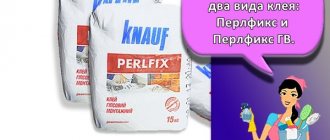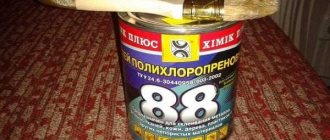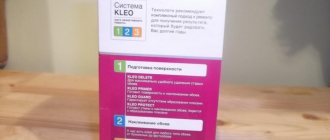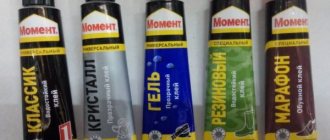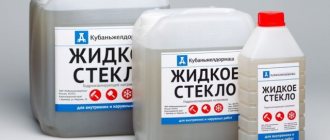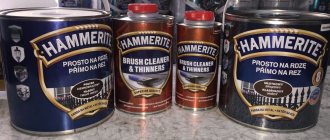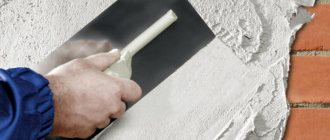EDP is a universal epoxy adhesive from the category of two-component compounds. It is suitable for reliable connection of any materials. The composition firmly glues ceramics and glass, but is not used for dishes in which food is prepared and served. The glue has good adhesion (degree of setting), strength, and low shrinkage. The finished seam is moisture-repellent and electrically insulating.
Purpose and features of EAF
The composition is used for filling floor niches, in handicrafts, decorating stone structures, and for restoring plastic coverings. Two-component adhesive creates an elastic seam after drying. It must be mixed immediately before use. The proportions and storage time are indicated on the packaging.
According to density it happens:
- clay-like (reminiscent of plasticine in the form of bars, for use it needs to be kneaded and evenly distributed on the surface);
- liquid (requires dilution, but is cheaper).
If the EDP contains solvents (polyamine or anhydride), then the polymerization process begins at room temperature.
Properties and scope of application of epoxy adhesives
The hardened adhesive forms a non-shrinking joint that is resistant to oils, alkalis and solvents. Epoxy has high adhesion to various substrates, easily tolerates sudden temperature changes in the range from -20 to +250 C, and is not an electrical conductor. The seam is elastic and can be sanded, painted, varnished and drilled. It is possible to add additional components to the main recipe, which gives the composition new properties.
Thanks to these properties, the material is widely in demand in many industries:
- Mechanical engineering. Production of abrasive tools, technical equipment, etc.
- Aircraft and astronautics. Production of solar panels, installation of thermal protection, internal and external, assembly of aircraft.
- Construction. Assembly of reinforced concrete bridge structures, three-layer building panels and much more.
- Shipbuilding and automotive industry. Assembly of fiberglass housings, fastening of parts from dissimilar materials, installation of highly loaded components, etc.
Photo: Instagram madewithdots
Properties and technical specifications
EDP glue is sold in polyethylene containers with a hardener in an additional bottle.
| Characteristic | Description |
| Appearance | Homogeneous viscous transparent mass without additional impurities |
| Operating time | 2-2.5 hours at a temperature of +18 oC - +25 oC |
| Shear strength grade | 8.0 MPa (for metal surfaces) |
| Warranty period of storage | 24 months |
It dries quickly, so you only need to fix the connected parts for 10-15 minutes. For the same reason, craftsmen recommend diluting epoxy glue in small volumes. The surfaces for gluing must be ready before preparing the composition itself. The finished seam can be additionally sanded, polished, sawed, or painted. The operating temperature at the time of joining the parts should be in the range from +18 °C to +25 °C.
Scope of application
Manufacturers make this adhesive composition using various modifiers. Product form: syringe or 280 g bottle. EDP glue in a syringe is easier to use, because it makes it easier to dose the adhesive solution and more accurately apply it to the surface.
The composition can be used for gluing surfaces:
- Ceramic.
- Porcelain stoneware.
- Porcelain.
- Wooden.
- Glass.
- Metal, steel.
- Plastic and other finishing and decorative materials.
Important! It is prohibited to use EDP glue for gluing materials and products that will come into contact with food during use.
The adhesive composition has a liquid structure, so it is often used to impregnate fillers (fabric, paper, sawdust, fiberglass, fiberglass, etc.). Similar work is carried out in various fields of industry: shipbuilding, mechanical engineering, machine tool building, etc.
In the domestic field, EDP glue is used for the restoration of cast iron and steel bathtubs, plumbing equipment, interior and furniture elements, various household appliances and electronics, as well as for the restoration of sports equipment, boats and other items.
Instructions for use
The parts that will be joined by EAF must be clean and dry.
To increase adhesion between surfaces, you can use a cloth (fiberglass or gauze).
Preparation
If necessary, parts are processed with sandpaper. Then they need to be wiped with acetone and allowed to dry completely in the open air. The solvent can be replaced with alcohol or gasoline. It will degrease the parts and remove dust.
Preparation of glue
To properly mix epoxy adhesive, you need instructions for use to ensure the correct proportions of the components are maintained.
- The bottle with resin must be immersed in warm water (+50 °C to +70 °C) and wait at least 10 minutes.
- For 1 part of hardener you need to take 10 times more epoxy resin, mix everything thoroughly. For exact proportions, rely on the divisions that are on the paper label of the glass container and the plastic bottle.
The finished composition is suitable for use for 2 hours.
Fillers
Additional components give the epoxy properties, such as acid resistance.
Fillers must be dry (powdery consistency). Typically, the filler portion is 25-30% of the total base. This applies to coloring pigments and plasticizers. Even a drop of water can ruin all the glue.
Applying glue
The finished composition must be applied to one of the surfaces in an even thin layer. Then the parts are connected and fixed. You can use a vice or weights. The surfaces must be left undisturbed until the joints are completely dry. Only then can you remove excess glue from the bases.
Curing time
The universal epoxy composition completely hardens within 24 hours (at room temperature). Curing time can be shortened by increasing the air temperature.
If the EAF does not dry, the video below will help.
Main features of the substance
Fast-curing epoxy adhesives quickly polymerize after adding a hardener to the base composition. The hardened mass has the following qualities:
- frost resistance (the mass can easily withstand temperatures down to -20⁰С);
- heat resistance (temperature limit at which the glue retains adhesion: up to +250⁰С);
- good ductility and elasticity, which ensures a high level of gluing strength;
- resistance to aggressive environments (acids, alkalis, oils, petroleum products, household chemicals);
- low shrinkage;
- water-repellent properties and high waterproofing performance;
- excellent interaction with almost all materials.
But you should also be aware of some of the disadvantages of such glue. For example, not all surfaces can be glued together - epoxy cannot bond Teflon, silicone and polyethylene . Take into account the accelerated polymerization time, so if there are flaws during gluing, it will be very difficult to remove them later.
Epoxy glue becomes completely safe only after it has completely cured. Before polymerization, it is toxic and harmful to health. This quality requires compliance with personal safety measures when working.
Glue does not work with all materials
Where is it used?
Due to its high technical qualities and versatility, epoxy adhesive is actively used in a variety of sectors of modern industry. Namely:
- in construction, to connect reinforced concrete structures and panels, glue is used to fill cracks and potholes in concrete, and it is used to lay tiles;
- shipbuilding uses an adhesive substance when installing and assembling ship parts made of fiberglass, plastic and metal; the substance is also used to improve the waterproofing qualities of materials;
- aviation (design), used for gluing various parts, manufacturing and installation of batteries, additional fixation for heat protection;
- mechanical engineering uses epoxy adhesive for mounting equipment, fastening brake pads and various parts when assembling machines, for various repairs.
Types of glue
Experts distinguish two large groups of adhesive epoxy composition. This:
- Liquid. Packaged in tubes. This form of release is convenient and easy to use.
- Plastic bars. Its consistency is similar to plasticine or dough. Also available in tube packaging. After squeezing out, the mass is slightly moistened with water and softened by hand.
Various modified formulations can also be found on sale. The temperature regime for polymerization of such modifications ranges from +60–120⁰С. Such adhesive substances are used for gluing various materials that are resistant to solvents, petrochemicals and oils.
Particularly strong in the line of epoxy adhesives are hot-curing masses (polymerization occurs at a temperature of +140–300⁰С). These modifications are characterized by high heat resistance and electrical insulation characteristics.
Several brands of epoxy glue are common in household and home use. They are recognizable and familiar to almost everyone:
- universal glue Moment;
- Contact intended for sealing pipes, repairing plumbing;
- Cold welding adhesive is intended for gluing metal products.
Is epoxy glue harmful to health?
When working with epoxy-based adhesive, you should be aware that it poses a health hazard. When working with it, the use of personal protective equipment becomes mandatory: gloves, respirator mask and goggles . If the adhesive mass gets into the stomach, a person runs the risk of serious poisoning, and contact with the skin leads to the development of allergic reactions.
Epoxy glue should not be used when gluing dishes and other items in contact with food.
Precautionary measures
Working with epoxy must be careful and safe. Need to work:
- in a well-ventilated (with ventilation) room;
- away from sources of heat, fire;
- wearing protective rubber gloves to prevent contact with skin.
If the mixture gets on the skin, it must be removed with a piece of clean cloth, and the area itself should be wiped with acetone and rinsed with water. The hardener is a toxic component, so you need to work with it carefully, preferably wearing a respirator and rubber gloves.
Two-component and one-component adhesive
The adhesive composition is produced in two forms, each of them is a complete material.
One-component composition
The ready-to-use mixture is available in small volume packaging. Due to the fact that the hardener has already been introduced into the mixture, the glue begins to harden immediately after opening the package. For this reason, the material is not used for working with large volumes, but is well suited for minor repairs, sealing seams, etc.
Photo: Instagram mechtairealnost
Fast curing EDP adhesive
The composition is suitable for fast and high-quality adhesion results. In this case, it is necessary to follow the recommendations that the manufacturer indicates on the packaging.
Advantages
In addition to the ability to dry quickly, fast-curing epoxy adhesive is distinguished by:
- increased degree of mechanical strength of the finished seam (under loads);
- minimal shrinkage, which is necessary for accurate calculation of layer thickness;
- used for different materials;
- resistance to cracking, sudden cold snaps, moisture and acids;
- property of electrical insulation of seams;
After hardening, the adhesive joint can be further processed, for example, by sanding the edges, drilling or painting.
Application
The working composition dries very quickly, so it is prepared in small portions, and the parts themselves are prepared in advance. Thus, the work is more accurate and economical. You can increase adhesion if you place a soaked piece of thin fabric (gauze or fiberglass) between the surfaces. The preparation of parts is similar to the use of a conventional EAF. Dust and grease can be removed with acetone or alcohol. Additionally, you can use sandpaper.
The epoxy glue should be diluted in a ratio of 10:1 (10 parts resin to one part hardener). You can work with the adhesive until its consistency begins to resemble jelly (the first 2 hours after preparation).
The fast cure mixture is applied to one side only. Fixation with a vice or with a weighting agent is necessary for the first 10 minutes. After this, the product must be left alone for another day, but the result will be lasting after 6 hours.
Craftsmen prefer this composition as cold welding.
The mixture is not suitable for working with polyethylene, silicone, or Teflon coatings. Due to the rapid hardening, there is practically no time left for adjusting the seams. When working with the fast-curing composition, respiratory tract and skin protection is necessary.
Universal epoxy glue EDP 280 g. 2736
EDP glue 280 g (Dzerzhinsk) 2,736 Two-component epoxy EDP glue Dzerzhinsk 280 g - intended for gluing at temperatures from +10 ° C to +30 ° C metals and their alloys, wood, ceramics, porcelain, glass, decorative facing and other materials, as well as for sealing pores, cracks, cavities when repairing household equipment and cars.
EDP adhesive is supplied as a set: base - modified epoxy resin in a polyethylene bottle and hardener in a glass bottle, contained in one consumer package.
Application:
- Clean the surfaces to be bonded using sandpaper, then wipe with a swab moistened with acetone, gasoline or alcohol, and dry in air.
- Prepare the adhesive composition immediately before use by thoroughly mixing 100 parts of modified epoxy resin with 10-12 parts of hardener.
- For 1 division on the plastic bottle, take approximately 1 division on the paper label of the glass jar. The adhesive composition should be prepared in small portions.
- The thickened resin must first be prepared by immersing the bottle for 8-10 minutes in a vessel with water at a temperature of 50-700 °C.
- The glue can be prepared with the addition of fillers, which are aluminum powder and any pigment dyes (ochre, red lead, etc.). All fillers must be dry.
- The amount of filler introduced is determined by the consistency of the glue: it is necessary to ensure that the composition remains fluid and can be easily applied to the surfaces to be glued.
- Apply the prepared glue in a thin layer to the prepared surfaces, connect them, compress them tightly using any devices and leave in this position until completely cured.
- Remove excess glue that is squeezed out when the parts are compressed. Complete curing at room temperature 20-250°C requires 24 hours. At elevated temperatures, curing time decreases, and at lower temperatures, curing time increases.
- The prepared glue is suitable for use within 1.5-2 hours.
- At the end of the warranty period (24 months), the adhesive is suitable for use, but the adhesive strength will be slightly reduced.
Precautions: If swallowed: drink water or milk, do not induce vomiting and consult a doctor. In case of contact with skin: wash with soap and water. In case of contact with eyes: rinse with water for 15 minutes. Keep out of the reach of children!
Composition: epoxy resin, plasticizer, hardener.
Volume/weight: 280 g (bottle)
Epoxy adhesive of the EDP brand is used for repairing interior items, as well as housings of household appliances, sports equipment and acoustic systems, plumbing fixtures, bathtubs, and washing machine tanks. It is also perfect for repairing and manufacturing fiberglass surfaces, bumpers, boat hulls, cars, modeling and production of self-leveling floors. The use of epoxy glue is quite universal; it is suitable for gluing materials such as metal, various alloys, glass, wood, porcelain, ceramics, etc. The only exception is the repair of dishes and objects that have direct contact with food.
Fast-curing adhesive is most convenient when quick repairs are needed. It provides the required level of strength of the adhesive joint after 6 hours and reduces labor intensity, and also increases the speed of the gluing process, making it possible to carry out the following technological operations without waiting for the gluing process to be completely completed.
Epoxy adhesive brand EDP is a two-component adhesive that contains a modified epoxy resin and a hardener. All components are hermetically packaged, each box has an individual tamper-evident warranty label designed to protect against unauthorized access.
EDP-2 Aqua
Volume : 60 g.
Price : 290 rub.
Specialized adhesive EDP-2 Aqua is intended for gluing and pouring small-sized products, as well as for repairing mechanisms and machines. If you need to glue plastic, porcelain and other materials, rely on EDP-2 Aqua , it will glue everything together perfectly.
Epoxy glue sets instantly and has increased moisture resistance, so it can be used in places where it is impossible to avoid water ingress. This glue is popular among people in everyday life.
For reference: before use, you need to mix the components 9 to 1, and also clean the surface and degrease.
Helpful tips for storing and disposing of glue
The manufacturer recommends storing the composition in a dry place, in an upright position. The integrity of the packaging should not be compromised, otherwise air will get inside, which will deteriorate the quality of the glue. The composition should only be stored at room temperature. Packaged epoxy can be stored for one to three years, but its properties deteriorate over time.
Working with glue requires the use of protective equipment, since it is very difficult to clean. While the composition is still liquid, you can wash it off with soapy water or acetone if the glue is already beginning to polymerize. Cured epoxy is very difficult to remove; you can try the following methods:
- Heating with an iron or hairdryer. When exposed to high temperatures, the glue softens and is easier to remove.
- Freezing with refrigerant. After this treatment, the composition becomes brittle and breaks off from the surface.
- Use of solvents. The glue is moistened with aniline, toluene, ethyl alcohol, etc. After some time, scrape off the stain.
Photo: Instagram kamindustry.ru
